IDEX Online Research: Polished Diamond Prices Continue to Slip in January
February 04, 09
Global polished diamond prices softened further in January 2009, continuing a trend that began late in the third quarter of last year. Prices softened as the global recession caused consumer demand to slacken in almost all markets around the world. Average polished diamond prices declined in January by 1.9 percent compared to December 2008.
In the U.S., which accounts for roughly half of all diamond jewelry sales globally, diamond jewelry sales at the retail level were estimated to have been down by 15-20 percent range during the all-important 2008 holiday selling season, and diamond jewelry sales were down between 8 percent and 9 percent for the full year, according to our estimates.
Aside from the Middle East and a few spots in Asia, most of the world’s other markets showed similar sales trends. Thus, it is no surprise that polished diamond prices are softening in line with weakening consumer demand.
Economic predictions vary more than ever, with some forecasters calling for an economic recovery beginning in the third quarter of this year, while others suggest that it could be early 2010 before the global economy begins to show a turn-around. Either way, it would appear that polished diamond demand in 2009 will remain soft for at least two or three more quarters.
We continue to caution diamantaires that “attitude” is everything. Sales may be weak, but the smart dealers continue to do business. Those merchants who see the glass as half full with lots of opportunities for filling it further will do better than merchants who see the glass as half empty and rapidly draining.
Long Term Price Trend Softening
The graph below illustrates polished diamond prices for the past 24 months. As expected, prices during January 2009 broke down through the long term growth rate. It is likely that polished diamond prices will continue to weaken for several more months, before reaching bottom and turning upward. Our long term forecast calls for diamond price inflation to resume at a more normalized rate, perhaps in 2010.
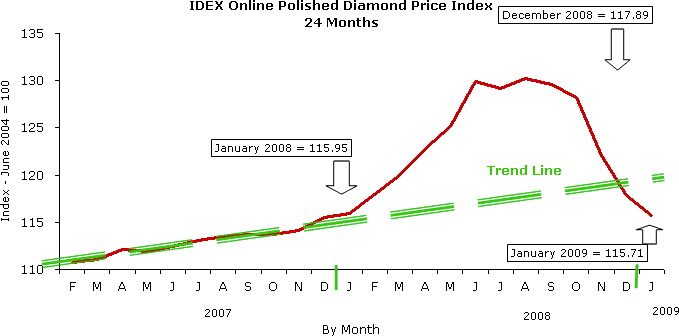
Source: IDEX Online Research
Prices for Large Polished Diamond Retracting More Rapidly
There’s an old adage: the bigger they are, the harder they fall. That adage could be applied to polished diamonds. Prices for the largest – and most expensive – diamonds rose faster and have fallen faster than prices for smaller, less expensive diamonds.
The graph below segments diamond price movements by key size. The diamonds shown on this graph represent about one-third of the market.
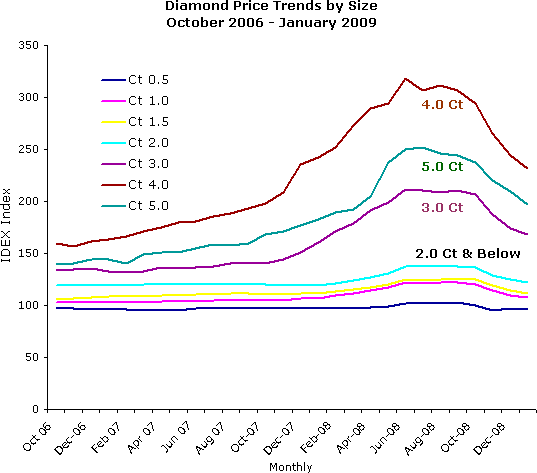
Source: IDEX Online Research
 |
January 2009 versus December 2008: (1.9%)
On an annualized basis, January’s price decline represents a 23 percent annual deflation rate. Clearly, that is an unrealistic deflation rate. The current deflationary trend is beneficial to downstream participants in the diamond pipeline since their margins have been squeezed for sometime, with a particular tightening in 2008. However, the mining sector is feeling a negative impact from lower revenues due to weaker demand and reduced prices for both rough and polished stones.
We believe history is a great forecaster for the future. If so, the rate of diamond price deflation will begin to moderate soon, and the longer term inflation rate will return. It may be several months before we reach bottom, but prices will bottom at some point. The IDEX Online Polished Diamond Price Index, calculated on the average daily prices during January 2009, stood at 115.71 for the month, down from 117.89 for the month of December 2008. At the end of January, the IDEX Online Polished Diamond Price Index had slipped to 112.91, reflecting a steady decline during the month. The IDEX Online Polished Diamond Price Index stood at 100.00 in July 2004.
The graph below summarizes month-over-month changes in global diamond prices for the past thirteen months. Beginning in February 2008, polished diamond prices showed large gains during every month in the first half of the year. Since then, price increases have moderated significantly as consumer demand has weakened.
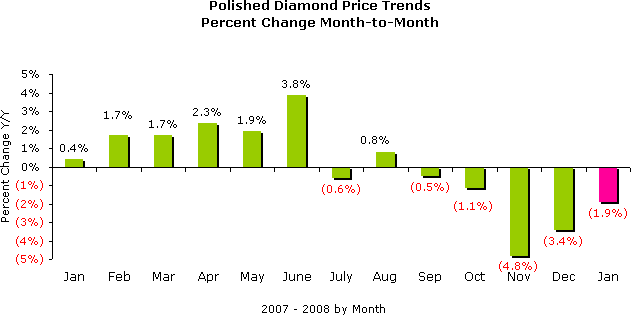
Source: IDEX Online Research
 |
On a year-over-year basis, global polished diamond prices slipped by a miniscule 0.2 percent in January 2009 versus the same month a year ago – January 2008. This was the sixth consecutive month of deceleration of year-over-year price increases for polished diamonds, and it was the first month that year-over-year prices dipped for polished diamonds. On an annualized basis, this suggests that prices might deflate by an additional 2-3 percent in 2009, a much more moderate rate than the month-to-month comparisons suggest.
On a year-over-year basis, virtually all key diamond sizes experienced very modest price deflation. We think that polished diamond prices are likely to continue to decline, though at a more modest rate, and will dip below the historical trend line inflation rate of 3-4 percent annually, before returning to their historic trend. The historical inflation rate of 3-4 percent annually is sustainable, in our opinion.
While some forecasters are predicting a “new economy,” diamonds and diamond demand have remained more or less on the sidelines during the recent turmoil last year. Thus, we believe that they are more likely to remain relatively untouched in the future, once the U.S. and the global economies stabilize. Based on 50,000 or more years of demand trends, we do not expect to see any major shift in consumer demand for diamonds or other jewelry.
The IDEX Online Polished Diamond Price Index stood at 115.71 in January 2009 versus 115.95 in January a year ago.
The graph below summarizes the year-over-year inflation rate by month for polished diamond prices in the global market for the past thirteen months.
Comparisons are based on the daily average prices during the month versus the same month a year ago. The year-to-year comparison takes into account the seasonality of polished diamond demand and prices.
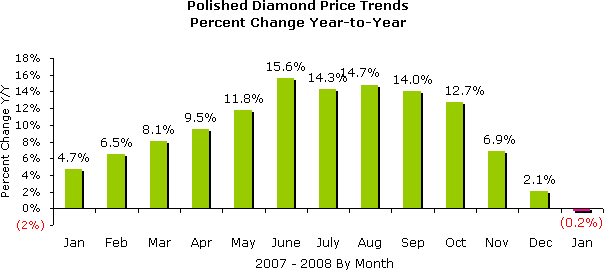
Source: IDEX Online Research
Daily Polished Prices Drifted Steadily Lower During the Month
Polished diamond prices drifted lower during the month of January, with a notable fall-off during the final days of the period. There was one notable price spike up early in the month, but it turned out to be false hope. Thus, price deflation during the month was reasonably orderly. After accelerating for the first half of 2008, polished diamond prices stabilized in June, and began decelerating at the end of the summer. This coincides with the slide of global financial markets as investors and merchants became more worried about the likelihood of a worldwide recession. Diamond traders found that they were unable to buy and sell diamonds at the artificially high prices reflected on some industry price lists; thus, overall asking prices declined slightly to more realistic levels. Still, there was no panic similar to that which characterized the global financial markets.
The following graph illustrates the average price of polished diamonds on a day-by-day basis for the three-month period November 2008-January 2009.
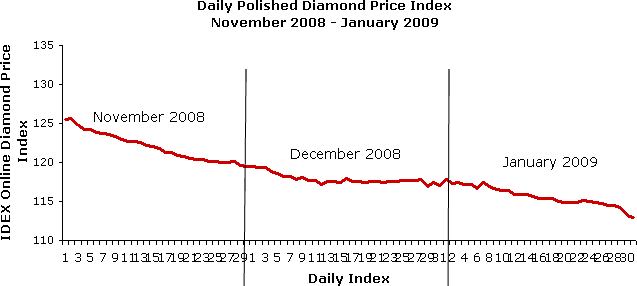
Source: IDEX Online Research
While the graph above represents an index of polished diamond prices, it is more instructive for diamantaires to understand how much – in U.S. dollars – polished diamond prices declined – or rose – during the month.
The graph below compares diamond prices for selected key diamond categories. The price comparisons are based on end-of-month prices – December 31, 2008 versus January 31, 2009.
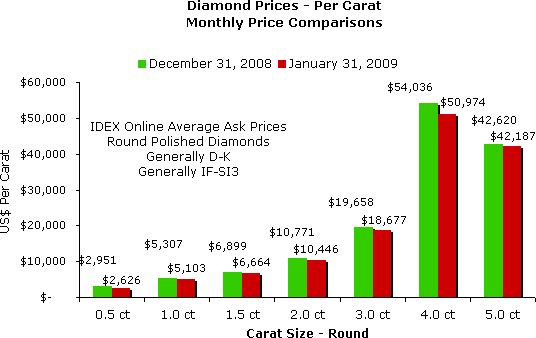
Source: IDEX Online Research
Month-to-Month Diamond Prices Decline for Most Sizes
After stabilizing for several months, month-to-month polished diamond prices have shown some decline for all of the key sizes. While demand had been strong in 2007 and early 2008 for large diamonds – in the 4-5 carat range – retailers are now seeing shoppers who are willing to compromise on either quality or size. Worried consumers are opting for more modest, according to retail merchants’ reports. Thus, prices for these larger stones have shown a greater decline than some of the other key sizes over the past month. Further, in January, prices for all of the key size polished diamonds fell; in prior months, prices for smaller diamonds had remained relatively steady.
The graph below summarizes the price changes for key sizes of polished diamonds on a month-over-month basis. These seven stone sizes represent about one-third of the trading market by value.
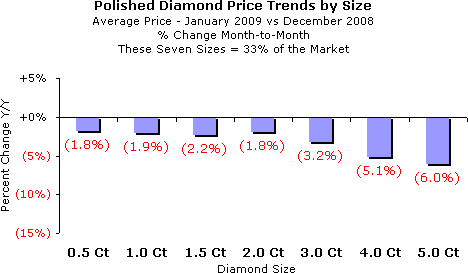
Source: IDEX Online Research
Year-Over-Year Diamond Prices for All Sizes Show Decelerating Inflation
On a year-to-year comparison, polished diamond prices slipped very modestly from the prior year. By size, there were no double-digit gains or losses in the month. In contrast, there was a string of double-digit price gains for many of the larger diamond sizes in 2008.
The graph below summarizes polished diamond prices by key sizes on a year-over-year basis.
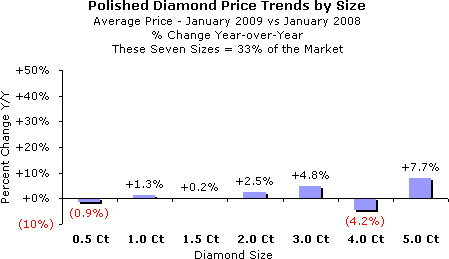
Source: IDEX Online Research
Forecast: Diamond Prices Likely to Continue to Soften
Like prices for all goods around the world, the talk of “inflation” has given way to talk of “deflation.” Deflationary pricing is not good for anyone or any economy. However, polished diamond prices rose at unrealistic rates in the first half of 2008, and now have retreated back to (or below) the long term growth rate. We don’t look for prices to stabilize soon. There simply is too much uncertainty related to the global economic situation. Further, the natural cycle calls for diamond prices to continue to decline, though perhaps at a slowing rate, before recovering to their historic trend line.
As we noted in prior months, if the diamond markets truly operate on the basis of capitalism, then demand and supply should help stabilize diamond prices as they retreat toward their historic inflation rate. Unfortunately, life doesn’t always work that way. For example, oil was unrealistically priced at $140 per barrel in mid-2008; it has now fallen to near $40-50 per barrel. Neither of these prices reflects true supply and demand, which some analysts see as stabilizing at $60-70 per barrel.
Likewise, diamonds could drop to unrealistically low prices before stabilizing and recovering sometime in 2009. While capitalism – and its inherent supply and demand – isn’t perfect, no one has come up with a better, more successful long term alternative.
The IDEX Online Diamond Price Index
The IDEX Online Diamond Price Index is a real-time index derived from actual asking prices in the global diamond industry. The IDEX Online Diamond Price Index objectively reflects price trends as they happen. The Diamond Index and Diamond Drivers were formulated following comprehensive research and analysis of the IDEX inventory database, aggregated since 2001. Research and development were conducted in cooperation with Dr. Avi Wohl, Senior Lecturer of Finance at the faculty of Management, Tel Aviv University, Israel.
Additional information is available from IDEX Research. The e-mail address is diamondprices [at] idexonline [dot] com.